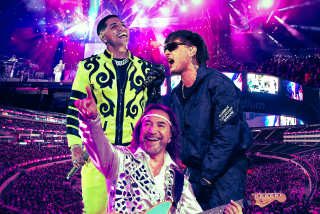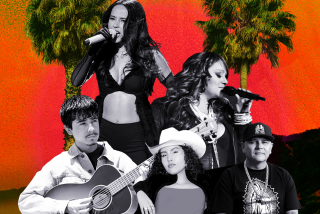More ‘El Lay’ Stories
If there’s one thing Los Illegals has plenty of, it’s rasquache spirit. That’s Spanish slang for do-it-yourself, an aesthetic essential to both Chicano and punk rock traditions in Los Angeles--particularly for this group that began in 1979 as a mariachi punk band.
Before Los Lobos began changing perceptions in the ‘80s, Willie Herron, a young Mexican American artist living in East L.A., found few venues where a group with the word “Los” in its name was welcome. So he called on that rasquache spirit to create a performance space for his and other East L.A. bands.
In a converted Catholic Youth Organization building--with the blessing of the nuns who ran the organization--Herron founded the first nightclub to feature Chicano punk and new wave groups. At Club Vex, Los Illegals cranked out a politically charged new wave that explored its five members’ status as intermediaries between Mexican immigrant and non-Latino communities.
More than a decade before Propositions 209 and 187, the group sang about the plight of the city’s immigrants in such songs as “El Lay,” which was about Herron’s stepfather, a dishwasher who was deported for being illegal.
But the band’s sound and message proved to be ahead of its time.
After releasing just one album, 1983’s “Internal Exile” on A&M; Records, Los Illegals dropped out of the L.A. music scene, limiting their performances after 1986 to art shows and concerts south of the border.
Now, a unique collaboration is bringing Los Illegals back for their first nightclub performance in L.A. in more than a decade. On Monday at the House of Blues, Los Illegals will team with singer Johnette Napolitano and guitarist Jim Mankey--who have revived the name of their disbanded L.A. rock group Concrete Blonde for the occasion--to celebrate the release of their joint album on Ark 21, “Concrete Blonde y Los Illegals.”
Herron, 43, hopes that L.A. may finally be ready for his band--now a trio of singer Herron, bassist Jesus “Xiuy” Velo and drummer Bill Reyes. The album, a fusion of flamenco-laced punk, folk and rock with lyrics in both Spanish and English, is a post-modern stew in which genres and languages collide and melt together.
“I’ve been influenced by all my family members using English and Spanish within the same sentence,” says Herron, looking youthful in black Levi’s, motorcycle boots, black patterned vest and wraparound sunglasses. “So for me to write songs that way is a natural thing, because that’s how I grew up speaking.”
Velo sees the collaboration with Concrete Blonde as an indication of things to come. The Spanglish--a mix of Spanish and English--featured on the album and sung by Napolitano as well as Los Illegals, is the language of the future, he says. “We’re mixing our blood, mixing our music, mixing our language, and everyone else should speak that way too, even the gabs [whites],” Velo says. “Everybody’s invited into this thing--if they want to come.”
Rock historian, musician and producer Ruben Guevara, who plans to include Los Illegals in the ‘70s-’80s volume of his ongoing, multi-volume Latin rock anthology, “Reconquista! The Latino Rock Invasion,” agrees.
“Hybridity is the future,” he says. “How can you not be a world musician these days? For me as a musician and a listener, it’s cool to draw from outside elements. That’s what L.A. is about.”
*
With such groups as the Voodoo Glow Skulls (bilingual ska-core punk) popping up on such L.A. radio stations as KROQ-FM and others like Ozomatli (multicultural acid-jazz salsa funk) and Yeska (Latin ska) performing in clubs throughout the city, it seems the seeds planted in the early ‘80s by Los Illegals and a handful of other Chicano punk and new wave groups--including the Plugz and the Brat--have finally taken root.
The new generation of Latino hybrid groups, as well as rock en espan~ol bands such as Maria Fatal (which is opening Monday’s show), are inheritors of Los Illegals’ vision, which was inspired as much by Herron’s involvement in the L.A. art scene as it was by his and Velo’s upbringing in East L.A.’s housing projects.
“Our lyrics were definitely related to our experiences in the barrio,” says Herron, outlining the difference between the East L.A. punk groups and such Hollywood counterparts as X and the Bags. “While everyone else was talking about girls in boots and zippers, and smoking cigarettes in the bar, we were talking about being deported and gang-banging, drive-by shootings, the issues in El Salvador. Our topics and inspiration were very, very serious.”
Even in their own neighborhoods, Los Illegals stuck out like sore thumbs. Their preference for rhinestones over Pendletons, top hats over bandannas, set them apart. Says Velo: “We were kids that grew up never being accepted.”
They also weathered encounters with record industry executives who had no idea how to market them. In that sense, little has changed. Until the recent launch of such labels as H.O.L.A. (Home of Latino Artists) and the reactivation of Rhino Records’ Zyanya division (which is putting out “Reconquista!”), U.S. Latino musicians have had few avenues to reach American listeners.
Velo and Reyes’ involvement with Napolitano as producers of Maria Fatal’s second rock en espan~ol album--”Pasiones, Torturas, y Otros Misterios,” on Aztlan Records, also out next week--is a sign of their determination to make things easier for the next crop of young American Latino musicians. Their plans include producing music by other Chicano bands in English as well.
“Personally, I take my hat off to anybody that can continue to create their art over a 20-year span,” says L.A. artist Diane Gamboa, a longtime fan of Los Illegals who attended many of their 1980s performances. “They’ve been able to sustain a sound that carries over throughout the decades.”
* Concrete Blonde y Los Illegals and Maria Fatal appear Monday at the House of Blues, 8430 Sunset Blvd., West Hollywood, 9 p.m. Sold out. (213) 650-1451.
More to Read
The biggest entertainment stories
Get our big stories about Hollywood, film, television, music, arts, culture and more right in your inbox as soon as they publish.
You may occasionally receive promotional content from the Los Angeles Times.










